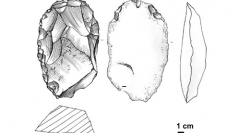

 Comptes Rendus Palevol
4 (3) - Pages 255-264
Comptes Rendus Palevol
4 (3) - Pages 255-264The Cave of the Monk from the village of Ban Fa Suai is an original site discovered by the Thai French Palaeosurvey during one of its field campaign looking for the remains of the first humans in northern Thailand. Preliminary data from geological, palaeontological and technolithic domains of this site are presented in this paper. Focusing on taphonomy it is an opportunity to describe evidence of a Stegodon-Ailuropoda fauna in a karstic context and the occurrence of Hoabinhian stone tools assemblages in a stacked overlain fossil gallery. The Cave of the Monk is a typical sample for several areas of South-East Asia. Sixteen families, 25 genus and 38 species of Mammals have been identified among the dental remains collected by procupines. The technological analysis shows that the lithic tools are similar to those originating from Indonesia.
Thailand, Pleistocene, Hoabinhian, Fauna, Taphonomy